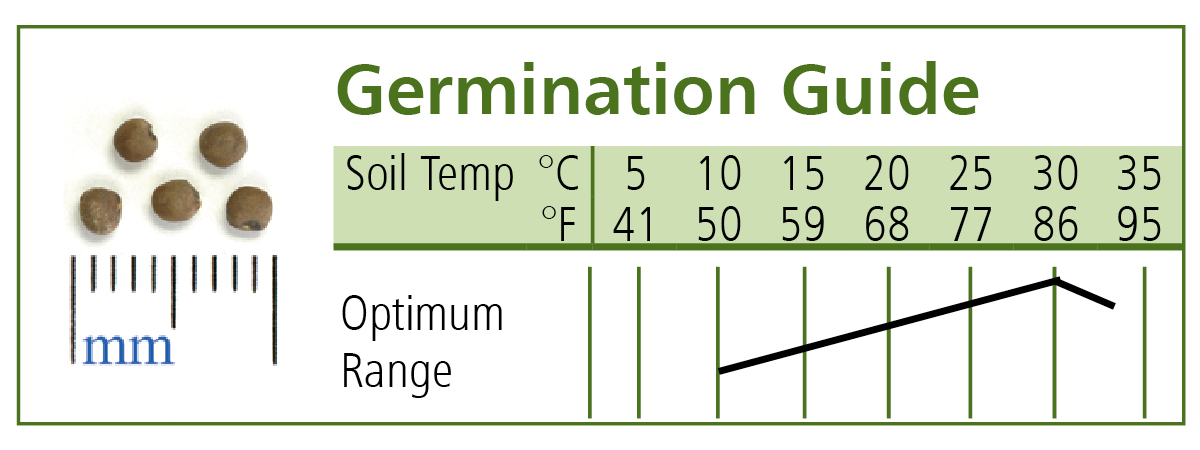Dagan
(F1) Brussels Sprout Seed
Product ID: 3633
Dependable midseason variety.
Perfect for selling "on the stalk" sprouts. Smooth, attractive, and holds very well in the field compared to others in this planting slot. Tall plants. Medium-large sprouts. Also available organic. Avg. 88,500 seeds/lb. Packet: 100 seeds.
https://www.johnnyseeds.com/vegetables/brussels-sprouts/dagan-f1-brussels-sprout-seed-3633.11.html
Size
Price
Quantity
Availability
CULTURE: Brussels sprouts prefer an irrigated, fertile soil with a pH above 6.0.
TRANSPLANTING: In May, sow 2–3 seeds per cell in 72-cell plug flats, 3–4 seeds/in. in 20 row flats, or in outdoor beds ¼" deep. Seedlings should be ready to transplant in 4–6 weeks. Space 18–24" between plants, in rows 30–36" apart. To maintain steady growth, the crop should be well fertilized and irrigated in dry weather.
DIRECT SEEDING: About 4 months before expected fall frost, sow 3 seeds every 18", ¼–½" deep, in rows 30–36" apart; thin to 1 plant per spot.
DISEASES: Adhere strictly to a preventive program including: (1) long crop rotations with noncruciferous crops, (2) clean starting mixes and outdoor seedbeds, and (3) strict sanitation practices. Black rot and black leg can be seed-borne. We only stock seed lots that have been tested free of black rot in a sample of 30,000 seeds. Individual seed lots have been tested free of black leg in a sample of 1,000 seeds.
NOTE: A disease-free test result means that in the sample tested, the pathogen targeted was not found. It does not guarantee a seed lot to be disease-free. However, no method of seed treatment can positively insure freedom from disease. We are glad to help with specific questions.
INSECT PESTS: Repel flea beetles and root maggots on young seedlings by covering with floating row covers from day of planting. Treat flea beetles with pyrethrin or azadirachtin if heavy pressure is observed. For cabbage worms and loopers, use Bacillus thuringiensis (Bt.). Cutworm prevention: Cultivate soil 2–4 weeks before planting to work in cover crops and destroy weeds.
HARVEST: After frost and until the end of December in most areas, and through the winter where cold is not severe. Pick when sprouts are firm and well formed, starting at the bottom of the stem. Break off the leaf below the sprout and snap off the sprout. The upper sprouts will continue to form and enlarge as the lower ones are harvested.
WHOLE-STALK HARVESTING, MARKETING, AND TOPPING: For a once-over harvest (uniform maturity of most sprouts on the plant) and whole-stalk marketing, the plants should be topped by pinching out the growing point (rosette of several small leaves at the top of the plant) when the lower sprouts are ½–¾" in diameter. A full stalk of uniform-size sprouts will develop in about 4 weeks.
STORAGE: Before ground freezes, pull plants out by the roots and place in a humid cooler at 32°F (0°C) or cold cellar for 4–6 weeks.
DAYS TO MATURITY: From transplanting; add about 20 days for direct seeding.
TRANSPLANTS: Avg. 800 plants/1,000 seeds.
SEED SPECS: SEEDS/LB.: See individual varieties.
PACKET: 100 seeds, sows 33'.
TRANSPLANTING: In May, sow 2–3 seeds per cell in 72-cell plug flats, 3–4 seeds/in. in 20 row flats, or in outdoor beds ¼" deep. Seedlings should be ready to transplant in 4–6 weeks. Space 18–24" between plants, in rows 30–36" apart. To maintain steady growth, the crop should be well fertilized and irrigated in dry weather.
DIRECT SEEDING: About 4 months before expected fall frost, sow 3 seeds every 18", ¼–½" deep, in rows 30–36" apart; thin to 1 plant per spot.
DISEASES: Adhere strictly to a preventive program including: (1) long crop rotations with noncruciferous crops, (2) clean starting mixes and outdoor seedbeds, and (3) strict sanitation practices. Black rot and black leg can be seed-borne. We only stock seed lots that have been tested free of black rot in a sample of 30,000 seeds. Individual seed lots have been tested free of black leg in a sample of 1,000 seeds.
NOTE: A disease-free test result means that in the sample tested, the pathogen targeted was not found. It does not guarantee a seed lot to be disease-free. However, no method of seed treatment can positively insure freedom from disease. We are glad to help with specific questions.
INSECT PESTS: Repel flea beetles and root maggots on young seedlings by covering with floating row covers from day of planting. Treat flea beetles with pyrethrin or azadirachtin if heavy pressure is observed. For cabbage worms and loopers, use Bacillus thuringiensis (Bt.). Cutworm prevention: Cultivate soil 2–4 weeks before planting to work in cover crops and destroy weeds.
HARVEST: After frost and until the end of December in most areas, and through the winter where cold is not severe. Pick when sprouts are firm and well formed, starting at the bottom of the stem. Break off the leaf below the sprout and snap off the sprout. The upper sprouts will continue to form and enlarge as the lower ones are harvested.
WHOLE-STALK HARVESTING, MARKETING, AND TOPPING: For a once-over harvest (uniform maturity of most sprouts on the plant) and whole-stalk marketing, the plants should be topped by pinching out the growing point (rosette of several small leaves at the top of the plant) when the lower sprouts are ½–¾" in diameter. A full stalk of uniform-size sprouts will develop in about 4 weeks.
STORAGE: Before ground freezes, pull plants out by the roots and place in a humid cooler at 32°F (0°C) or cold cellar for 4–6 weeks.
DAYS TO MATURITY: From transplanting; add about 20 days for direct seeding.
TRANSPLANTS: Avg. 800 plants/1,000 seeds.
SEED SPECS: SEEDS/LB.: See individual varieties.
PACKET: 100 seeds, sows 33'.
Johnny's is committed to your success, every step of the way.
We want you, our customer, to be 100% satisfied with all of our seeds, tools, and supplies.
If anything you purchase from us proves unsatisfactory, we will either replace the item or refund the purchase price.


